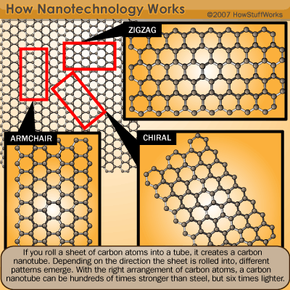Nanowires and Carbon Nanotubes
Currently, scientists find two nano-size structures of particular interest: nanowires and carbon nanotubes. Nanowires are wires with a very small diameter, sometimes as small as 1 nanometer. Scientists hope to use them to build tiny transistors for computer chips and other electronic devices. In the last couple of years, carbon nanotubes have overshadowed nanowires. We're still learning about these structures, but what we've learned so far is very exciting.
A carbon nanotube is a nano-size cylinder of carbon atoms. Imagine a sheet of carbon atoms, which would look like a sheet of hexagons. If you roll that sheet into a tube, you'd have a carbon nanotube. Carbon nanotube properties depend on how you roll the sheet. In other words, even though all carbon nanotubes are made of carbon, they can be very different from one another based on how you align the individual atoms.
Advertisement
With the right arrangement of atoms, you can create a carbon nanotube that's hundreds of times stronger than steel, but six times lighter [source: The Ecologist]. Engineers plan to make building material out of carbon nanotubes, particularly for things like cars and airplanes. Lighter vehicles would mean better fuel efficiency, and the added strength translates to increased passenger safety.
Carbon nanotubes can also be effective semiconductors with the right arrangement of atoms. Scientists are still working on finding ways to make carbon nanotubes a realistic option for transistors in microprocessors and other electronics.
In the next section, we'll look at products that are taking advantage of nanotechnology.
